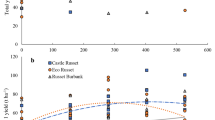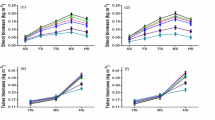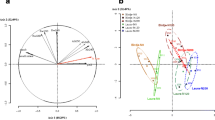Abstract
Proper management of N, P, and K fertilizers is considered very important to maximize tuber yield and attain desirable processing quality. Generally, farmers apply NPK fertilizer rates based on the preplant soil tests. However, very limited information is available on the influence of available soil nutrients and in-season NPK application rates on yield and quality of tubers. In the present study, paired soil and tuber samples were evaluated from 170 commercial production sites to evaluate potential relationship between soil nutrients, tuber yield, and tuber quality. These paired samples gave us the opportunity to not only study yield response to fertilizer application rates but also study the relationship between soil nutrient availability and tuber nutrient concentrations. We found that about 50%, 80%, and 70% of farmers applied more NPK than recommended rates, respectively. Our results suggest that, in general available soil NPK increases tuber NPK concentrations and tuber N and K concentrations can reduce specific gravity. Interestingly, tuber P concentration had no effect on specific gravity. We also found some variations in these responses to nutrients (NPK) among cultivars suggesting some genetic control for the traits studied. Results also suggest that application of NPK fertilizers in excess of recommended rates on soils that are already rich in these nutrients does not increase tuber yields and may in fact increase potential environmental degradation associated with excessive fertilization and the cost of production.
Resumen
El manejo apropiado de los fertilizantes de N, P y K se considera muy importante para maximizar el rendimiento de tubérculo y obtener una calidad deseable de procesamiento. Generalmente, los agricultores aplican niveles de fertilizantes NPK con base en las pruebas de suelo previas a la siembra. No obstante, se dispone de muy limitada información sobre la influencia de los nutrientes disponibles del suelo y en los niveles de aplicación de NPK durante el ciclo sobre el rendimiento y calidad de los tubérculos. En el presente estudio se evaluaron muestras apareadas de suelo y tubérculo de 170 sitios comerciales de producción para considerar la relación potencial entre los nutrientes del suelo, y el rendimiento y calidad de tubérculo. Estas muestras apareadas nos dieron la oportunidad de no nada más estudiar la respuesta en rendimiento a la aplicación de niveles de fertilizante, sino también de estudiar la relación entre la disponibilidad de nutrientes del suelo y la concentración de nutrientes del tubérculo. Encontramos que cerca de 50%, 80% y 70% de los productores aplicaron mas NPK que los niveles recomendados, respectivamente. Nuestros resultados sugieren que, en general, el NPK disponible en el suelo aumentan las concentraciones de NPK en el tubérculo, y que las concentraciones del N y el K del tubérculo pueden reducir la gravedad específica. Lo interesante es que la concentración del P no tuvo efecto en la gravedad específica. También encontramos algunas variaciones en estas respuestas a los nutrientes (NPK) entre las variedades, lo que sugiere algún control genético para los caracteres estudiados. Los resultados también sugieren que la aplicación de los fertilizantes NPK en exceso de los niveles recomendados en suelos que ya son ricos en estos nutrientes, no aumenta los rendimientos de tubérculo y pudieran, de hecho, incrementar la degradación ambiental potencial asociada con fertilización excesiva y los costos de producción.





Similar content being viewed by others
References
Abdalla, G., M. Guinazu, R. Tizio, D.W. Pearce, and R.P. Pharis. 1995. Effect of chloroethyl trimethyl ammonium chlorides on tuberisation and endogenous GA3 in roots of potato cuttings. Plant Growth Regulation 17: 95–100.
AbdelGabdir, A.H., M.A. Errebhi, H.M. Al-Sarhan, and M. Ibrahim. 2003. The effects of different additional levels of potassium on yield and industrial qualities of potato (Solanum tuberosum L.) in an irrigated arid region. American Journal of Potato Research 80: 219–222.
Allison, M.F., J.H. Fowler, and E.J. Allen. 2001a. Factors affecting the magnesium nutrition of potatoes (Solanum tuberosum L.). Journal of Agricultural Sciences 136: 397–409.
Allison, M.F., J.H. Fowler, and E.J. Allen. 2001b. Responses of potato (Solanum tuberosum L.) to potassium fertilizers. Journal of Agricultural Sciences 136: 407–426.
Alvarez-Sanchez, E., J.D. Etchevers, J. Ortiz, R. Nunez, V. Volke, L. Tijerina, and A. Martinez. 1999. Biomass production and phosphorus accumulation of potato as affected by phosphorus nutrition. Journal of Plant Nutrition 22: 205–217.
Belanger, G., J.R. Walsh, J.E. Richards, P.H. Milburn, and N. Ziadi. 2002. Nitrogen fertilization and irrigation affects tuber characteristics of two potato cultivars. American Journal of Potato Research 79: 269–279.
Blakemore, L. C., P. L. Seatle, and B. K. Daly. 1987. Methods for chemical analysis of soils, New Zealand soil bureau scientific report 10A, Department of Scientific and industrial research (DSIR), Wellington.
Busse, J.S., and J.P. Palta. 2006. Investigating the in vivo calcium transport path to developing potato tuber using 45Ca: A new concept in potato tuber calcium nutrition. Physiologia Plantarum 128: 313–323.
Burton, W.G., A. Van Es, and K.J. Hartmans. 1992. The physics and physiology of storage. In The potato crop: The scientific basis for improvement, ed. P.M. Harris, 2nd ed., 608–727. London: Chapman and Hall.
Cultivated Soil Classification Committee. 1995. Classification of cultivated soils in Japan third approximation. Tsukuba: National Institute for Agro-Environmental Sciences.
Curtin, D., C.E. Wright, M.H. Beare, and F.M. McCallum. 2006. Hot water-extractable nitrogen as an indicator of soil nitrogen availability. Soil Science Society of America Journal 70: 1512–1521.
Deguchi, T., K. Iwama, and A.J. Haverkort. 2016. Actual and potential yield levels of potato in different production systems of Japan. Potato Research 59: 207–225.
Department of Agriculture, Hokkaido Government. 2015. Hokkaido fertilizer recommendations 2015, Hokkaido Agricultural Policy, Planning Department, Sapporo.
Edgar, A.D. 1951. Determining the specific gravity of individual potatoes. American Potato Journal 28: 729–731.
Errebhi, M., C.J. Rosen, S.C. Gupta, and D.E. Birong. 1998. Potato yield response and nitrate leaching as influenced by nitrogen management. Agronomy Journal 90: 10–15.
FAO. 2017. FAOSTAT. http://faostat.fao.org. Accessed October, 2018.
Fernandes, A.M., and R.P. Soratto. 2016. Response of potato cultivars to phosphate fertilization in tropical soils with different phosphate availabilities. Potato Research 59: 259–278.
Fontes, P.C.R., H. Braun, C. Busato, and P.R. Cecon. 2010. Economic optimum nitrogen fertilization rates and nitrogen fertilization rate effects on tuber characterization of potato cultivars. Potato Research 53: 167–179.
Gondwe, R.L., R. Kinoshita, M. Sano, T. Suminoe, D. Aiuchi, H. Koaze, J. Palta, and M. Tani. 2017. Lack of yield response in potato (Solanum tuberosum L.) to phosphate fertilizer under contrasting soil types varying in phosphate absorption coefficient and available phosphate. Soil Science and Plant Nutrition 63: 171–177.
Hashimoto, H. 2008. Inventory of the local soil types of arable land in Hokkaido (revised edition), Miscelleneous publication of Hokkaido prefectural agricultural experiment Station, Naganuma. (in Japanese).
Hochmuth, G., P. Weingartner, C. Hutchinson, A. Tilton, and D. Jesseman. 2002. Potato yield and tuber quality did not respond to phosphorus fertilization of soils testing high in phosphorus content. HortTechnology 12: 420–423.
Houghland, G.V.C. 1960. The influence of phosphorus on the growth and physiology of the potato plant. American Potato Journal 37: 127–138.
Hopkins, B.G., J.W. Ellsworth, T.R. Bowen, A.G. Cook, S.C. Stephens, V.D. Jolley, A.K. Shiffler, and D. Eggett. 2010. Phosphorus fertilizer timing for russet Burbank potato grown in calcareous soil. Journal of Plant Nutrition 33: 529–540.
Hopkins, B. G., K. J. Fernelius, and D. L. Eggett (2018) AVAIL phosphorus fertilizer enhancer: metalysis of 503 field evaluations. Agronomy Journal 110: 389–398.
Iwama, K. 2008. Physiology of potato: New insights into root system and repercussions for crop management. Potato Research 51: 333–353.
Japan Metrological Agency. 2017. Monthly data 2005 to 2014. http://www.data.jma.go.jp/obd/stats/etrn/view/monthly_s3_en.php?block_no=47417&view=13Accessed 1 March 2018.
Joern, B.C., and M.L. Vitosh. 1995. Influence of applied nitrogen on potato part I: Yield, quality, and nitrogen uptake. American Potato Journal 72: 51–63.
Kang, W., M. Fan, Z. Ma, X. Shi, and H. Zheng. 2014. Luxury absorption of potassium by potato plants. American Journal of Potato Research 91: 573–578.
Kjeldahl, J. 1883. A new method for the determination of nitrogen in organic matter. Zeitschrift für Analytische Chemie 22: 366–382.
Kleinkof, G.E., D.T. Westermann, M.J. Wille, and G.D. Kleinschmidt. 1987. Specific gravity of russet Burbank. American Journal of Potato Research 64: 579–587.
Kratzke, M.G., and J.P. Palta. 1985. Evidence of existence of functional roots on potato tubers and stolons: Significance in water transport to the tuber. American Journal of Potato Research 62: 227–236.
Kumar, P., S.K. Pandey, B.P. Singh, S.V. Singh, and D. Kumar. 2007. Influence of source and time of potassium application on potato growth, yield, economics and crisp quality. Potato Research 50: 1–13.
Laboski, C.A.M., and K.A. Kelling. 2007. Influence of fertilizer management and soil fertility on tuber specific gravity: A review. American Journal of Potato Research 84: 283–290.
Maltas, A., B. Dupuis, and S. Sinaj. 2018. Yield and quality response of two potato cultivars to nitrogen fertilization. Potato Research 61: 97–114.
Ministry of Agriculture, Forestry and Fisheries. 2016. 2014 Municipality Harvest Amount of Annual Production of Potatoes for 2014 Season (Sakkyo-Chosa-Shicyosonbetsu-Data-Heisei-26-Nendo). http://www.maff.go.jp/j/tokei/kouhyou/sakumotu/sakkyou_yasai/. Accessed 1 July 2019.
Mori, K., K. Asano, S. Tamiya, T. Nakao, and M. Mori. 2015. Challenges of breeding potato cultivars to grow in various environments and to meet different demands. Breeding Science 65: 3–16.
Mosley, A.R., and R.W. Chase. 1993. Selecting cultivars and obtaining health seed lots. In Potato health management, ed. R.C. Rowe, 19–27. Minnesota: APS Press.
Murphy, J., and J.P. Riley. 1962. A modified single solution method for the determination of phosphate in natural water. Analytica Chimica Acta 27: 1–36.
Nagy, P. T. 2000. Application of an element analyzer for soil and plant analyses (dry combustion method). Agroke’mia e’s Talajtan 49: 521–534.
Nanzyo, M. 1997. Phosphate absorption coefficient. In Methods of Soil Environment Analysis (Dojyo-kanko-Bunsekihou), ed. Editorial Committee for Methods of soil environment analysis (Dojyo-kankyo-Bunsekihou-Henshu-linkai), pp.262–264. Hakuyusha, Tokyo. (in Japanese).
Painter, C.G., and J. Augustine. 1976. The effects of soil moisture and nitrogen on yield and quality of the russet Burbank potato. American Journal of Potato Research 65: 119–125.
Palta, J.P. 2010. Improving potato tuber quality and production by targeted calcium nutrition: The discovery of tuber roots leading to a new concept in potato nutrition. Potato Research 53: 267–275.
Rosen, C.J., and P.M. Bierman. 2008. Potato yield and tuber set as affected by phosphorus fertilization. American Journal of Potato Research 85: 110–120.
Rosen, C., N. Sun, N. Olsen, M. Thornton, M. Pavek, L. Knowles, and N.L. Knowles. 2018. Impact of agronomic and storage practices on acrylamide in processed potatoes. American Journal of Potato Research 95: 319–327.
Ruark, M.D., K.A. Kelling, and L.W. Good. 2014. Environmental concerns of phosphorus management in potato production. American Journal of Potato Research 91: 132–144.
Schollenberger, C.J., and F.R. Dreibelbis. 1930. Analytical methods in base-exchange investigations on soils. Soil Science 30: 161–173.
Scott, G.J., and F. Zelada. 2011. Benchmarking local potato processing in developing countries: The case of French fries in Lima, Peru. Potato Research 54: 29–44.
Sharma, U.C., and B.R. Arora. 1988. Effect of nutrients on starch, proteins, and sugars in potatoes. Food Chemistry 30: 313–317.
Sharma, L.K., S.K. Bali, and A.A. Zaeen. 2017. A case study of potential response of increased soil phosphorus levels in the Northeast United States. Agronomy Journal 85: 1–15.
Soil Survey Staff. 2014. Keys to soil taxonomy. 12th ed. Washington, DC: USDA-Natural Resource Conservation Services.
Sommerfeld, T.G., and K.W. Knutson. 1965. Effects of nitrogen and phosphorus on the growth and development of russet Burbank potatoes grown in the southeastern Idaho. American Potato Journal 42: 351–360.
Sun, N., C.J. Rosen, and A.L. Thompson. 2017. Nitrogen response of French fry and chip cultivars selected for low tuber reducing sugars. American Journal of Potato Research 94: 606–616.
Tani, M., C. Mizota, T. Yagi, T. Kato, and M. Koike. 2010. Vertical distribution and accumulation of phosphate in virgin soils and arable soils of Tokachi district, Hokkaido. Japanese Journal of Soil Science and Plant Nutrition 81: 350–359 (in Japanese with English summary).
Tani, M., C. Mizota, T. Yagi, N. Fueki, H. Tamura, T. Kato, and M. Koike. 2011. Accumulated amount and formation of phosphate in cultivated upland low-humic Andisols through continuous application of inorganic fertilizers and cattle manure for 25 years. Japanese Journal of Soil Science and Plant Nutrition 82: 224–227 (in Japanese).
Truog, E. 1930. The determination of the readily available phosphorus of soils. Agronomy 22: 874–882.
USDA–Foreign Agricultural Service. 2016. Potato and potato products annual. https://gain.fas.usda.gov/Recent%20GAIN%20Publications/Potatoes%20and%20Potato%20Products%20Annual_Tokyo_Japan_10-4-2016.pdf. Accessed 1 July 2019.
Van der Bom, F., J. Magid, and L.S. Jensen. 2017. Long-term P and K fertilization strategies and balances affect soil availability indices, crop yield depression risk and N use. European Journal of Agronomy 86: 12–23.
Vos, J. 1997. The nitrogen response of potato (Solanum tuberosum L.) in the field: Nitrogen uptake and yield, harvest index and nitrogen concentration. Potato Research 40: 237–240.
Vreugdenhil, D., and L.I. Sergeeva. 1999. Gibberellins and tuberisation in potato. Potato Research 42: 471–481.
Wang, Y., A.J. Bussan, and P.C. Bethke. 2012. Stem-end defect in chipping potatoes (Solanum tuberosum L.) as influenced by mid environmental stresses. American Journal of Potato Research 89: 392–399.
Westermann, D.T., T.A. Tindall, W. James, and R.L. Hurst. 1994. Nitrogen and potassium fertilization: Yield and specific gravity. American Potato Journal 71: 417–431.
Westermann, D.T., and T. A. Tindall. 2000. Potassium diagnostic criteria for potato plants. Idaho, Better crops, volume 84, No 3.
Westermann, D.T. 2005. Nutritional requirements of potatoes. American Journal of Potato Research 83: 301–307.
Zelalem, A., T. Tekalign, and D. Nigussie. 2009. Response of potato (Solanum tuberosum L.) to different rates of nitrogen and phosphorus fertilization on Vertisols at Debre Berhan, in the central highlands of Ethiopia. African Journal of Plant Science 2: 016–024.
Acknowledgements
The research was supported by Calbee Potato Inc., Japan and the Obihiro University of Agriculture and Veterinary Medicine. We would like to thank growers of Tokachi and Kamikawa districts for allowing us to use their fields for our study.
Author information
Authors and Affiliations
Corresponding author
Ethics declarations
Conflict of Interest
The authors declare no conflict of interest.
Rights and permissions
About this article
Cite this article
Gondwe, R.L., Kinoshita, R., Suminoe, T. et al. Available Soil Nutrients and NPK Application Impacts on Yield, Quality, and Nutrient Composition of Potatoes Growing during the Main Season in Japan. Am. J. Potato Res. 97, 234–245 (2020). https://doi.org/10.1007/s12230-020-09776-2
Published:
Issue Date:
DOI: https://doi.org/10.1007/s12230-020-09776-2




